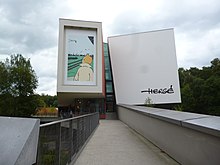Hergé Museum

|
|
| Data | |
|---|---|
| place | Louvain-la-Neuve |
| Art |
Art museum
|
| architect | Christian de Portzamparc |
| opening | June 2, 2009 |
| management |
Laurent de Froberville
|
| Website | |
The Hergé Museum ( French : Musée Hergé ) was opened on June 2, 2009 in Louvain-la-Neuve . It shows the work of the Belgian comic author and illustrator Hergé , making it the first museum in Europe dedicated to a comic artist . The museum is at 26 rue du Labrador because Tintin and Struppi live on this street.
history
During Hergé's lifetime, the idea of building a museum to present his extensive oeuvre came up. The Hergé Foundation (French: Moulinsart) (formerly: Studios Hergé ), founded three years after the artist's death, continued to pursue this goal. Initially, Brussels was under discussion as the home of the future Hergé Museum, but after years of discussions about the location, due to the lack of suitable building land in the capital, it was announced on January 10, 2001 that the museum would be built in the university town of Louvain-la-Neuve. Hergé's widow, Fanny Rodwell, provided 17 million euros for this purpose. After a total of seven years of planning and almost three years of construction, the museum was opened on June 2, 2009.
architecture
The museum was built by the French architect Christian de Portzamparc . He designed an angled, light-flooded building with numerous inclines that is surrounded by nature. A long wooden walkway leads to the entrance of the white building made of glass and concrete. The museum consists of four units, which are connected by bridges and glass passages. The eight exhibition rooms are located in these.
exhibition
The design of the exhibition was created by the Dutch artist Joost Swarte . The exhibition begins on the third floor, where the first four exhibition halls are, and continues on the second floor, where the other four halls are. The exhibition area covers a total of 2000 square meters.
The exhibits include numerous original drawings, title pages, first prints, source material, but also Hergé's personal belongings and private photographs. The exhibits are not sorted chronologically , rather the halls are designed according to subject areas. Comments are used sparingly, but audio guides are available.
Le Petit Vingtième
The Le Petit Vingtième is the bistro of the Hergé Museum. The name comes from Le Petit Vingtième , a children's supplement from Le Vingtième Siècle , in which the first Tintin stories appear.
criticism
In the course of reporting on the opening of the museum, the lack of critical examination of the person Hergé was sometimes criticized. Die Welt criticizes : The visitor learns absolutely nothing about his sympathy for Brussels' racist politics in the Belgian Congo and Nazi Germany - which the artist later openly regretted - about his sometimes reactionary, arch-Catholic upbringing or even his severe depression . The Frankfurter Allgemeine Zeitung also writes: But then [...] there is no clarifying word about the controversial role of the draftsman in those years.
The fact that the journalists who had traveled to the museum were strictly forbidden to take photos and that they had to hand over their cameras before entering the exhibition caused a scandal . This measure was taken to prevent a large number of images of the originals exhibited in the halls.
Individual evidence
- ↑ Frankfurter Rundschau, June 2, 2009.
- ↑ Julia Schäfer: Hergé Museum opens. Tintin you can touch. (No longer available online.) Tagesschau , May 31, 2009, archived from the original on May 19, 2010 ; accessed on February 22, 2014 .
- ↑ The difficult route to the "Tim and Struppi" museum , Die Welt . June 6, 2009.
- ^ Destination fame , Frankfurter Allgemeine Zeitung . May 31, 2009.
- ↑ Les médias interdits de montrer le musée Hergé , Le Soir . May 25, 2009.
Web links
- Official website of the museum (French)
Coordinates: 50 ° 40 '16.42 " N , 4 ° 36' 45.28" O

